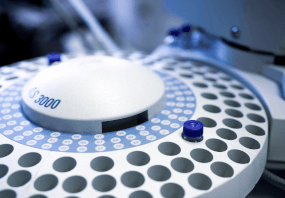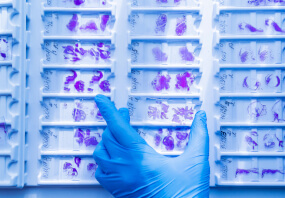General description
Histone H3 is one of the five main histone proteins involved in the structure of chromatin in eukaryotic cells. Featuring a main globular domain and a long N-terminal tail, H3 is involved with the structure of the nucleosomes of the ′beads on a string′ structure. The N-terminal tail of histone H3 protrudes from the globular nucleosome core and can undergo several different types of epigenetic modifications that influence cellular processes. These modifications include the covalent attachment of methyl or acetyl groups to lysine and arginine amino acids and the phosphorylation of serine or threonine
Specificity
Broad species cross-reactivity is expected
Histone H3 phosphorylated at Serine 10
Immunogen
Peptide containing the sequence RK[pS]TG. in which pS corresponds to phospho-serine at position 10 of human histone H3
Application
Anti-phospho-Histone H3 (Ser10) Antibody, clone MC463 is a rabbit monoclonal antibody for detection of Histone H3 phosphorylated at serine 10. This mAb, also known as H3S10p, is specificity verified using DB & Mplex, published in peer reviewed journals & validated in ChIP, IF, WB, ICC, ChIP-seq.
Research Category
Epigenetics & Nuclear Function
Research Sub Category
Histones
Western Blot Analysis:
A 1:2,000-1:4,000 dilution of this lot detected phosphorylated histone H3 in acid extracted proteins from mitotic HeLa cells (Catalog #17-306) treated with colcemid (lane 1) vs. untreated cells (lane 2) (Figure A).
Beadlyte
A 1:5,000 dilution of a previous lot was incubated with histone H3 peptides containing various modifications conjugated to Luminex
Immunofluorescence:
Representative image from a previous lot.
Positive chromosome immunostaining for mitotic HeLa cells and A431 cells.
Chromatin Immunoprecipitation:
A previous lot was shown to be suitable for ChIP by an independent laboratory.
Quality
routinely evaluated by immunoblot on acid extracted proteins from mitotic HeLa cells
Target description
17kDa
Linkage
Replaces: 05-817
Physical form
Cultured supernantant in 0.05% sodium azide.
Storage and Stability
Stable for 1 year at -20°C from date of receipt.
Handling Recommendations: Upon receipt, and prior to removing the cap, centrifuge the vial and gently mix the solution. Aliquot into microcentrifuge tubes and store at -20°C. Avoid repeated freeze/thaw cycles, which may damage IgG and affect product performance.
Analysis Note
Control
UV-treated 293 cell extracts, UV-treated HeLa cell extracts, breast cancer tissue, HEPG2 cell extracts
Legal Information
UPSTATE is a registered trademark of Merck KGaA, Darmstadt, Germany
Disclaimer
Unless otherwise stated in our catalog or other company documentation accompanying the product(s), our products are intended for research use only and are not to be used for any other purpose, which includes but is not limited to, unauthorized commercial uses, in vitro diagnostic uses, ex vivo or in vivo therapeutic uses or any type of consumption or application to humans or animals.
Shipping Information:
Dry Ice Surcharge & Ice Pack Shipments: $40
More Information: https://cenmed.com/shipping-returns
- UPC:
- 51313512
- Condition:
- New
- Availability:
- 3-5 Days
- Weight:
- 1.00 Ounces
- HazmatClass:
- No
- MPN:
- 04-817
- Temperature Control Device:
- Yes












